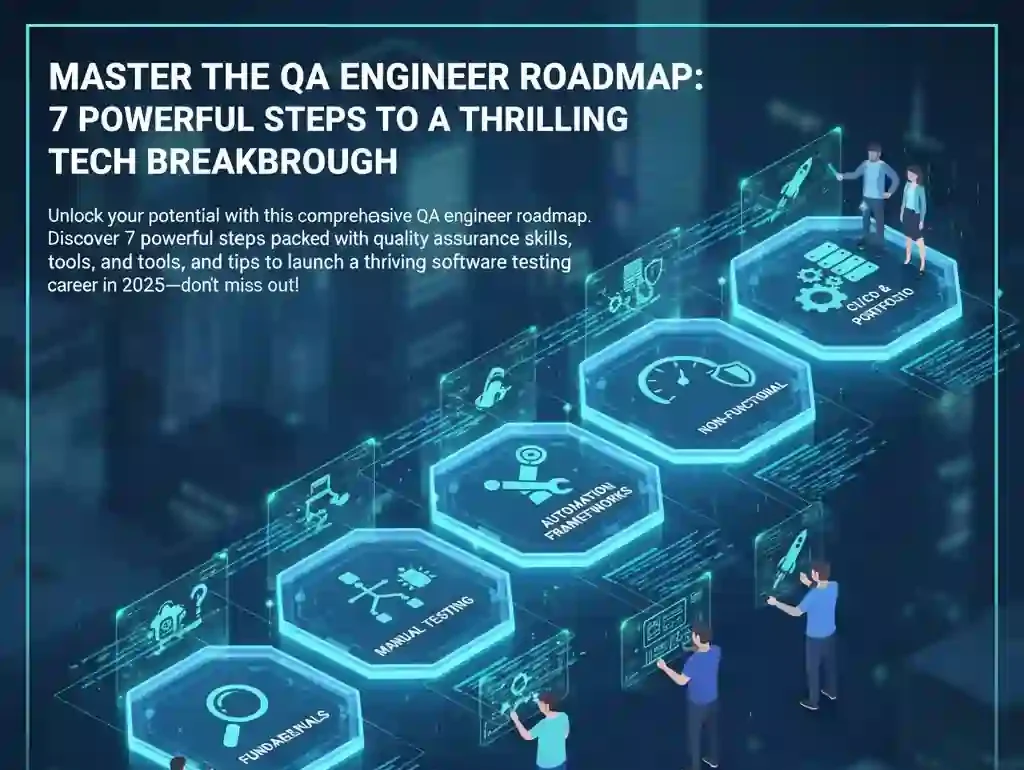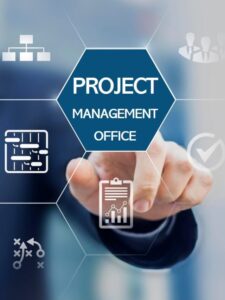Hey there, future bug-buster. Ever stared at a glitchy app and thought, “Someone’s gotta fix this”? That’s the spark that lights up a QA engineer’s world. In today’s fast-paced tech scene, where apps crash faster than your weekend plans, quality assurance isn’t just a checkbox; it’s the hero keeping chaos at bay. If you’re plotting your software testing career, you’ve landed in the right spot.
This QA engineer roadmap isn’t some dusty guide; it’s your battle plan for 2025. We’ll break down seven powerhouse steps, blending quality assurance skills with real talk on manual testing techniques and automation testing frameworks. By the end, you’ll have actionable tips, stats that hit hard, and stories from folks who’ve turned “tester” into “team lead.” Ready to level up? Let’s dive in.
Table of Contents
Why Chase a Software Testing Career in QA Right Now?
Picture this: You’re the gatekeeper ensuring software doesn’t flop on launch day. Sounds vital, right? The U.S. Bureau of Labor Statistics pegs employment for software developers, quality assurance analysts, and testers to surge 15% from 2024 to 2034, way faster than average. That’s about 140,100 openings yearly in the U.S. alone. And with AI shaking things up, QA roles are booming as the “safest bet” in tech, per recent market analyses.
But it’s not all numbers. A software testing career offers stability, creativity, and that sweet spot where tech meets problem-solving. No PhD required, just curiosity and grit. Think remote gigs, six-figure salaries after a few years, and the thrill of spotting flaws others miss. If you’re detail-oriented with a dash of skepticism, this path fits like a glove.
Step 1: Nail the Fundamentals of Quality Assurance Skills
Every epic journey starts small. In your QA engineer roadmap, fundamentals are the foundation. Skip ’em, and you’re building on sand.
Cultivate That QA Mindset:
First off, adopt the QA mindset: Question everything. It’s not negativity; it’s healthy doubt. Ask, “What if this breaks under load?” or “Does this button work on a flip phone?”
Actionable tip: Journal your daily tech fails. That coffee app that ghosts your order? Note why. Over a week, you’ll spot patterns like poor error handling. Pro fact: Teams with a strong QA mindset catch 40% more defects early, slashing fix costs by up to 100x, according to IBM studies.
Grasp Test Oracles and Prioritization:
Test oracles? Fancy term for your “truth source”, like specs or user expectations that say if a test passes. Prioritization? Rank bugs by impact: Critical crashes first, cosmetic tweaks last.
Real-world example: At a mid-sized e-commerce firm, a junior QA prioritized login bugs over UI tweaks. Result? Avoided a Black Friday meltdown, saving thousands in lost sales.
Tools to start: Freebies like qTest for tracking or TestRail for basics. Spend 10 hours practicing; it’ll stick.
Step 2: Unpack Testing Approaches Like a Pro
Your QA engineer roadmap next hits approaches: White-box (peek inside the code), black-box (treat it like a mystery box), and gray-box (a sneaky hybrid).
Black-box shines for end-users, test inputs without code dives. White-box? Coders’ delight in edge cases. Gray? Best for APIs.
Stat alert: 70% of bugs hide in black-box scenarios, per a 2023 Capgemini report. Tip: Alternate approaches weekly. Simulate a black-box by closing your IDE; force white-box with pseudocode reviews.
Case study time: Sarah, a bootcamp grad, stuck to black-box in her first gig at a fintech startup. She missed integration snags. Switched to gray-box? Caught a $50K vulnerability. Lesson: Mix it up for coverage.
Step 3: Master Manual Testing Techniques for Solid Ground
Manual testing? The hands-on heart of quality assurance skills. No scripts, just you exploring like a detective.
Key techniques: Smoke (quick health check), sanity (post-fix verification), regression (old bugs reborn?), and exploratory (free-form hunting).
How-to: Craft test cases, inputs, steps, and expected outputs. For a login page: Enter valid creds, except dashboard. Invalid? Error message.
Bullet-point basics:
- Compatibility checks: Test across browsers (Chrome, Safari) and devices (iOS, Android).
- UAT prep: Role-play users; note pain points.
- Verification vs. validation: Does it meet specs (verification)? Delight users (validation)?
Fun fact: Manual catches 30% more usability issues than automated, says a Forrester study. Drawback? Time-suck. Hybridize it with automation later.
Example: Tom’s team at a health app company ran exploratory sessions. Uncovered a gesture bug on tablets, fixed pre-launch, boosting user retention by 15%.
Step 4: Level Up with Automation Testing Frameworks
Ah, the game-changer in any QA engineer’s roadmap: Automation. Why click manually when scripts do it 24/7?
Start with frameworks like Selenium for web, Appium for mobile. Cypress? Speedy for frontend; Playwright? Cross-browser beast.
Picking Your First Automation Testing Framework:
Beginner pick: Selenium WebDriver, free, vast community. Install via npm, write in JavaScript.
Code snippet (don’t sweat it):
const { Builder } = require('selenium-webdriver');
let driver = await new Builder().forBrowser('chrome').build();
await driver.get('https://example.com');
await driver.quit();
Tip: Automate repetitive stuff first, like form submissions. Aim for 20% coverage in month one.
Stat: Teams automating tests ship 30% faster, per Atlassian’s DevOps report. But beware over-automation, it’s brittle.
Case study: Mike, ex-manual tester, dove into Cypress at a SaaS firm. Built a suite catching regressions overnight. Promotion in six months.
Step 5: Tackle Non-Functional Testing Like a Boss
Functional? Checks “what.” Non-functional? “How well?” Load, performance, security, and your QA engineer’s roadmap must cover these.
Load and Performance Deep Dive:
Simulate traffic spikes. Tools: JMeter (free, robust), k6 (scriptable).
Actionable: Baseline your app’s response time. Under 2 seconds? Gold. Over? Optimize.
Fact: 53% of mobile users bail if load takes over 3 seconds, Google stats.
Security and Accessibility Musts:
Security: Scan for OWASP Top 10 (SQL injections, anyone?). Tools: OWASP ZAP.
Accessibility: WAVE or Axe for WCAG compliance. Tip: Alt-text every image.
Example: A banking app team ignored accessibility—faced a lawsuit. Post-audit? Inclusive design, 20% more users.
Step 6: Weave QA into SDLC Models Seamlessly
Software Development Life Cycle (SDLC) models like Agile, Waterfall, Scrum? QA fits everywhere.
In Waterfall: Test at end (risky). Agile/Scrum: Embed in sprints—daily standups, continuous feedback.
Kanban? Visualize bug flow on boards.
Tip: In Scrum, pair with devs for “shift-left” testing, catch early, save late.
Real-world: Netflix’s QA in CI/CD pipelines? Zero-downtime deploys, serving 200M+ users.
Step 7: CI/CD, Monitoring, and Portfolio Polish
Cap your QA engineer roadmap with integration.
CI/CD tools: Jenkins, GitHub Actions. Automate builds, tests, deploys.
Monitoring: Sentry for errors, Grafana for metrics.
Build a portfolio: GitHub repo with test scripts, case reports.
Actionable tips:
- Contribute to open-source bugs.
- Mock interviews on Pramp.
- Network on LinkedIn, “QA engineer roadmap” posts get 2x engagement.
Case study: Lisa, self-taught, shared her automation framework on GitHub. Landed a remote role at a unicorn startup. From zero to hero in 9 months.
Actionable Tips to Supercharge Your QA Engineer Roadmap
You’re not just reading, you’re doing. Here’s your cheat sheet:
- Daily drill: 30 mins on freeCodeCamp’s testing modules.
- Tool trial: Week one, Selenium; week two, Postman for APIs.
- Cert chase: ISTQB Foundation, boosts resume 25%, per surveys.
- Community connect: Join Reddit’s r/QualityAssurance; ask “Best manual testing techniques for APIs?”
- Track wins: Log defects squashed; celebrate small victories.
Remember, consistency trumps intensity. One hour daily beats cramming.
Wrapping Up: Your Thrilling QA Adventure Awaits
There you have it, the QA engineer roadmap distilled into seven steps that pack a punch. From mindset shifts to automation mastery, you’ve got the blueprint for a software testing career that’s equal parts challenging and rewarding. Bugs won’t squash themselves, but with these quality assurance skills, you’ll squash them like pros.
What’s your first move? Drop a comment below, I’d love to hear. Now go forth, test boldly, and build that breakthrough.
FAQs
How long does it take to complete a QA engineer roadmap and land a job?
It varies, but most folks nail basics in 3-6 months with 10-15 hours weekly. Add portfolio time, and you’re job-ready in 6-9 months. Focus on hands-on projects over theory.
What are the top quality assurance skills for beginners in software testing career?
Start with manual testing techniques like test case writing and bug reporting. Add basics in Agile and tools like Jira. Communication? Key: explain issues without jargon.
Which automation testing framework should I learn first for QA?
Selenium’s your gateway drug, versatile, free. If frontend-focused, try Cypress for its simplicity. Practice on a personal project, like automating a to-do app.
How do manual testing techniques complement automation in QA?
Manual excels at exploratory and usability checks; automation handles repetition. Blend ’em: 60/40 split early on. Teams doing this cut release times by 40%.
Is a software testing career in QA safe amid AI advancements in 2025?
Absolutely, AI aids, doesn’t replace. QA pros who adapt (think AI test generation) thrive. Market growth? 15%+, with 140K openings yearly.
























